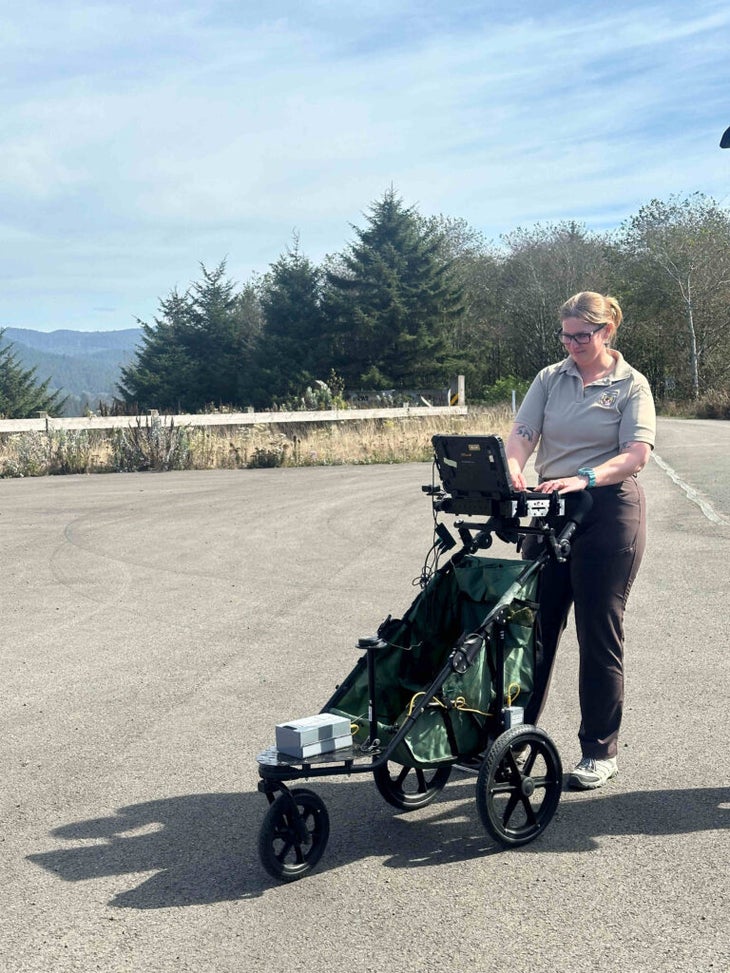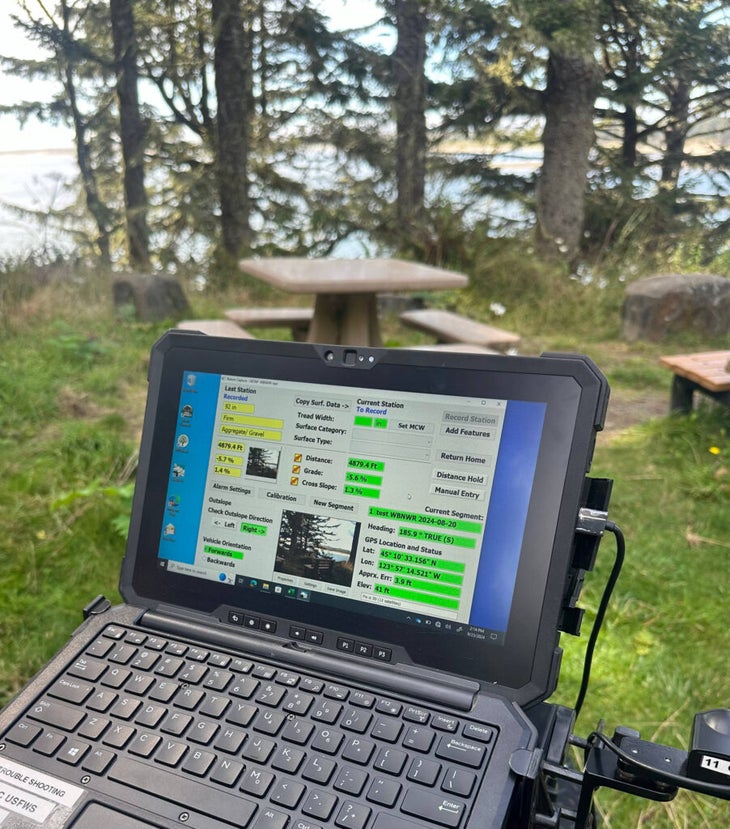Heading out the door? Read this article on the new Outside+ app available now on iOS devices for members! Download the app.
Every Monday, Franklin Ouchida, 61, waits in his wheelchair at a trailhead in Portland for friends to arrive for their regularly scheduled group hike. Always on his lap is his dog Cutie, a 4-year-old miniature pinscher with big, kind eyes.
“She’s a great icebreaker,” Ouchida says. “People will start to talk to me about her and then I can talk to them about Oregon Wheelchair Hiking.”
Through a Facebook group with 400 engaged members, Ouchida has led group hikes around the Portland metro area for the last three years, at first sporadically and now consistently. Another wheelchair hiker started the group in 2020, but Ouchida took over leadership in 2021. A retired businessman, he didn’t hike before using a chair. Now it’s his thing, and he’s never missed a Monday.
On the group’s hikes, both manual and electric wheelchair users roll up and then roll out along winding paths that range from 3 to 5 miles long and which Ouchida scouts ahead of time.
“It looks like a bunch of crazies in wheelchairs going down a bike trail,” he says. “It really warms my heart to see people who would never talk to each other go out on a trail and become friends.”
Not every trail is open to wheelchair users, though. Ouchida takes precautions to select routes that are accessible, favoring pavement and crushed gravel over mud and wood chips. He also takes note of curbs, gates, and any other barriers that could limit the group’s access. Proximity to public transportation is another factor, since some wheelchair users don’t drive.
While many trails in the area fit their needs—like the Kronberg Park Multi-Use Trail along a scenic creek, or the 6-mile Trolley Trail, which is part of a planned 20-mile paved loop—many could still use improvements. It’s a work in progress, Ouchida says, and he’s serving on a transportation committee to make accessibility recommendations to community leaders.
To the west of Portland, communities along the Oregon Coast serve as a model for accessible trail access. Many are making a concerted effort to design outdoor infrastructure for people with a variety of different needs. Several cities, like Seaside and Florence, roll out non-slip Mobi-mats on the beach for people with wheelchairs, walkers, canes, and other mobility devices. A few locations even offer free loaner beach wheelchairs that have large, wide wheels capable of navigating sand.
When it comes to hiking trails along the coast, accessibility is also getting better. The U.S. Fish & Wildlife’s Pacific Region is the first in the agency to use a machine called the High Efficiency Trail Assessment Process—HETAP for short—which captures data that’s especially important to mobility aid users. It’s still in the pilot phase, and there are some kinks to work out before all USFWS regions can use it.

Park ranger Taryn Sutton operates the machine, a collection of electronics mounted to a stroller, to measure a trail’s grade, width, length, cross slope, surface type, location of benches, and other features. She’s wheeled the HETAP on several miles of trails at the Nestucca Bay National Wildlife Refuge, the Siletz Bay National Wildlife Refuge, and the Brandon Marsh National Wildlife Refuge. Progress is slow: It takes Sutton 30 minutes to an hour to complete half a mile depending on the trail, as she has to stop every 20 feet so it can sense.
The data is published on the agency’s website, presented in bullet points for distance, typical and max grade, route type, surface type, average and minimum width, and bench locations. Easy, moderate, and difficult ratings are often subjective, but the HETAP’s data output is one solution for describing trails more accurately. Ouchida says wheelchair users can use the information to decide for themselves if they are willing to try a trail or need to bring someone with them. While many manual wheelchair users might not know what grade they can push, he says that many at least know what surface, width, and distance they can handle.
“By providing this information, it lets people know that they are welcome here,” Sutton says.
Information is often a barrier for wheelchair users, affirms Matt Howard, the outdoor recreation coordinator for OSCIC, which plans monthly group hikes in the spring. “Any vagueness or ambiguity turns a lot of people off from a program,” he says.

Beyond Oregon, outdoor recreation areas across the country are prioritizing updates to outdated infrastructure that follow universal design principles, creating spaces that are useful and accessible to people with a wide range of abilities and preferences. As part of the U.S.’s 2024 budget, the National Park Service requested $5 million to support parks working with the disability community to improve physical and programmatic accessibility.
This summer, both Crater Lake National Park and Olympic National Park asked for the public’s input on accessibility barriers and solutions for possible accommodations, such as improving slopes, adding audio recordings and braille to facilities, and building more accessible parking. They’re using the feedback to draft a plan for improvements.
Now that it’s the rainy season in the Pacific Northwest, Ouchida’s group hikes have adjusted slightly. Rather than getting stuck in a downpour, the group meets at indoor malls to roll under the safety of a roof. Ouchida says he’ll also plan pop-up hikes with a day’s notice when the weather is nice. Then in April, they’ll head back to the trails.
Consistency is crucial because it gives people more of a reason to show up, he says. When he first needed a wheelchair 12 years ago, he could have benefitted from the accountability of a group.
“When you’re first injured, you think of all the bad things that could happen. Like, I could fall out of my chair or my batteries could run out,” Ouchida says. “In your mind, you talk yourself out of it…that’s why I think these groups are really important to get people out to try different things.”
Ouchida recalls how during one hike, two nonverbal wheelchair users—one with ALS and one who had experienced a stroke—talked the whole time to each other through their computers. That’s what it’s all about, he says. It helps normalize wheelchairs on the trails.
“You don’t often see a group of people in wheelchairs doing things.” But, he adds, “People in wheelchairs can do it too.”
From 2025